Are you worried and asking yourself, “why are drones following me”? Drone surveillance is becoming common, with personal privacy at risk from both hobbyist drone operators and police departments.
This article will help you understand the troubling reasons why drones might track you, how to spot their behavior patterns, and what steps can protect your safety. Read on to regain peace of mind!
Key Takeaways
Drones can trail you for innocent reasons—like hobbyists snapping pictures or companies testing delivery routes—but some use them for stalking or spying.
Police departments rely more on drones for surveillance these days, with New York agencies alone registering 876 drones by 2024, marking a 65% jump in just two years.
If you notice a drone shadowing you, note the exact time, place, and how it’s flying; afterward, try locating the pilot or call local authorities and the FAA at 844-359-6982.
Drone harassment incidents keep rising, with the UK recently reporting over 2,400 cases involving drones spying on individuals.
Technical glitches can sometimes make drones unintentionally follow people—especially if radio signals or cell towers nearby disrupt their controls.
Table of Contents
Possible Reasons for a Drone Following You
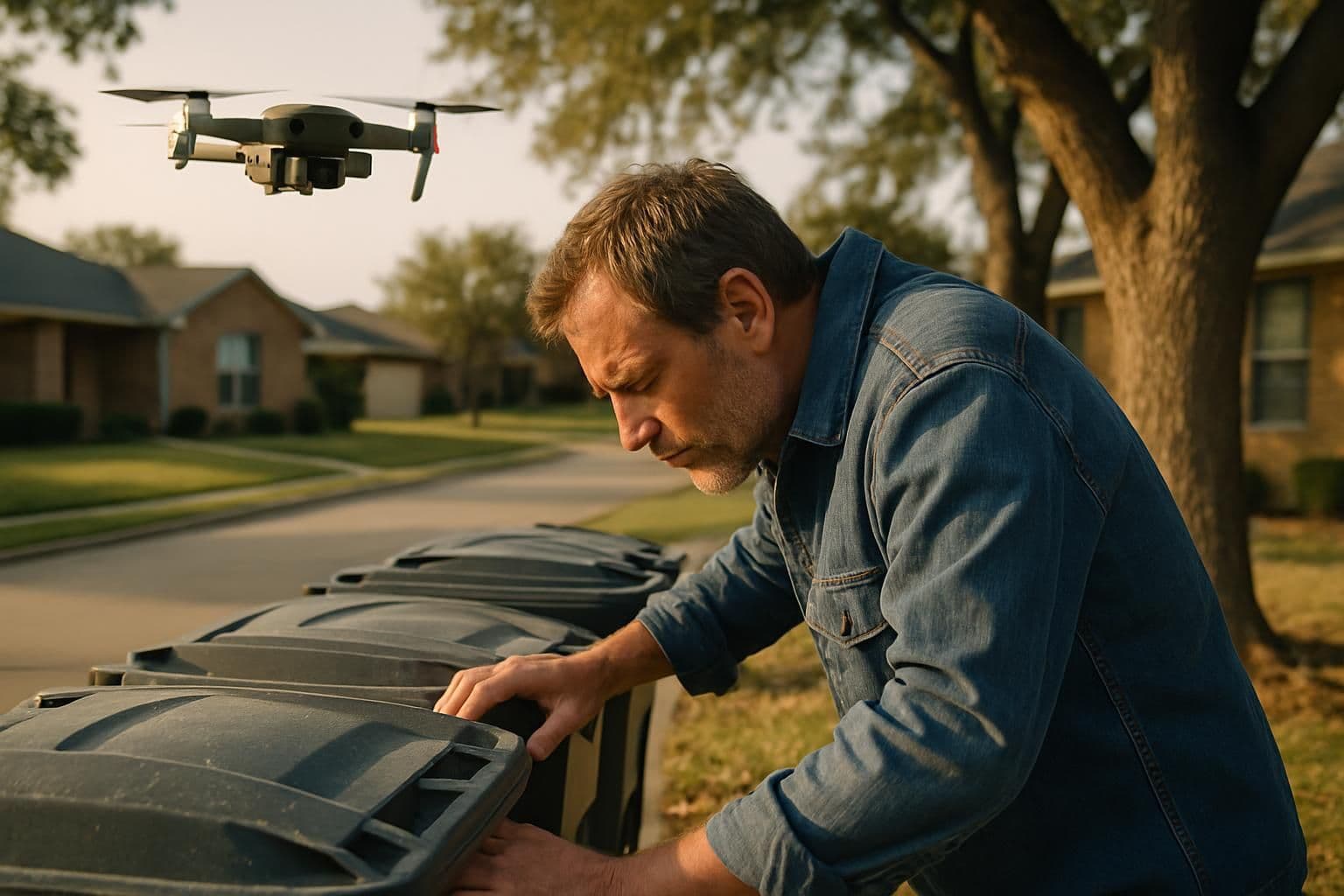
Drones can follow you for many reasons that range from harmless to harmful. You need to know these reasons to decide if you should worry about that buzzing sound above your head.
Hobbyist Drone Enthusiasts
People who fly drones as a hobby sometimes take aerial photos that accidentally include you. These small, unmanned aircraft buzz around parks or neighborhoods, as pilots practice maneuvers or capture interesting shots.
Most drone operators aren’t trying to spy—they’re just enjoying their hobby—but it can feel uncomfortable if the device lingers above your property a little too long. The boundary between harmless fun and invading someone’s privacy can blur surprisingly quickly.
Feeling uneasy about a drone that hovers near you for several minutes is completely understandable. Amateur drone enthusiasts who control these aircraft remotely might not realize how their actions appear to those below.
The Federal Aviation Administration (FAA) clearly states hobby flyers must always keep drones within visual range and away from other people. Unfortunately, some operators aren’t aware of these rules—or simply choose not to follow them.
If you notice a drone closely following your movements, trust your instincts—it may be smart to check it out and call local authorities.
Delivery Testing by Companies
Big-name tech firms like Amazon Prime Air and Google Wing are currently testing their drone delivery services right in local neighborhoods.
You could easily encounter these unmanned aerial vehicles during your morning run—or even spot one floating overhead while kids play nearby. I once saw an Amazon drone following along my usual jogging path; it hovered close by, matched my pace for roughly half a mile, then abruptly shifted direction.
These drones aren’t out randomly; they gather important flight data to sharpen skills in steering clear of humans and everyday obstacles.
Companies running drone tests must stick strictly to FAA guidelines, although—honestly—the tests might still feel slightly intrusive. Through neighborhood trials, drones gain critical experience in safely dropping packages without crashing into trees, buildings, or pedestrians.
Before drones can reliably deliver your groceries or online orders, their flying skills require significant real-life practice. Local law enforcement also keeps a close eye on these drone experiments, making sure public safety remains protected at every stage.
Law Enforcement or Security Operations
Police departments throughout the United States regularly deploy drones as airborne surveillance. Agencies like the NYPD send up these drones to monitor protests, track down suspects, or quickly assess incoming 911 emergency calls.
By 2024, New York government agencies alone had registered 876 drones—climbing 65% in only two years. The rapid spread of these flying cameras sparks real concerns about privacy rights and civil liberties.
Some departments now run “Drones As First Responders” programs, or DFR for short. These programs send unmanned aircraft straight to emergency sites, often arriving well before human police.
The drones can easily capture sensitive details—such as a person’s face or body heat—without needing a warrant. Critics argue that this unchecked drone use may lead to mistaken arrests and excessive monitoring of ordinary people.
As drone use expands, balancing public safety with privacy becomes increasingly challenging—and even controversial.
Commercial or Professional Use
Drones go far beyond law enforcement these days. Businesses use drones for all sorts of helpful tasks. Professional filmmakers and photographers capture breathtaking aerial images, shots that once needed expensive helicopters.
Real estate agents rely on drones to show properties from the sky, offering buyers a clear view of homes, land, and neighborhoods. GPS systems and advanced sensors have made these flying cameras essential in various fields.
Drones have transformed how we capture and monitor our world from above.
Companies in mapping and surveying depend on drones to measure land precisely. Environmental groups study wildlife and habitats from a safe distance, without bothering the animals they’re watching.
Security teams at large companies fly drones to keep an eye on facility grounds and quickly spot trouble. Popular models like the DJI Mavic 3 feature high-quality cameras perfect for these activities—but even top gear can fail occasionally.
One DJI Mavic 3 lost control, hitting a neighbor’s house, proving errors can happen to anyone. Sports experts also record practices and games with drones, helping teams sharpen their strategies and improve performances.
Malicious Intent or Stalking
Unfortunately, some people are using drones for troubling purposes. Kim, for instance, experienced this firsthand, after her ex-husband used a drone to spy on her during a New Year’s Eve party.
Sadly, this form of harassment occurs more frequently than most realize. People stalking others may use drones equipped with cameras—to spy, gather personal details, or simply create fear.
Even private investigators sometimes misuse these airborne gadgets, conducting surveillance that crosses legal boundaries. Their small size and quiet engines make drones ideal devices for those with questionable intentions.
Beyond stalking, criminals sometimes use these flying devices for even more serious offenses. They can survey homes secretly from above, preparing for burglaries, or watch security measures around properties to plan a break-in.
Corporate spying is another risk—criminals might send drones to secretly capture sensitive details through office windows or at outdoor meetings. If you think someone is watching you this way, carefully document every detail—the drone’s appearance, flight paths, and behaviors.
Taking clear photos or videos of these incidents can give authorities solid proof if you file a report. Getting familiar with ways to avoid drone surveillance is quickly becoming an essential skill in today’s advanced technological environment.
Technical Issues or Malfunctions
Drones can accidentally follow people because of technical issues. Signal interference often causes drones to behave oddly, pushing them toward random targets. I once saw my DJI Mavic 3 suddenly swerve off path during a routine test—it almost crashed into my neighbor’s backyard.
Glitches in drone software can trigger unintended tracking as well. Sometimes GPS systems malfunction, causing drones to mistakenly latch onto moving objects for guidance. These problems happen more frequently than drone manufacturers openly admit, particularly near crowded radio signals or cell phone towers.
The FAA has hundreds of documented reports of drones acting unpredictably because of technical faults.
Even thermal imaging equipment in high-tech drones can go haywire, making them chase heat signals given off by people. Complex drone algorithms might break unexpectedly, causing drones to track the wrong targets.
My friend once had his Skydio drone trail a jogger for nearly half a mile before he finally regained control. Problems like these raise real privacy worries, since drones could capture unplanned photos or personal data without the owner’s knowledge.
Harsh weather, powerful winds, and electromagnetic storms can make these drone malfunctions even worse. Spotting unusual drone behaviors can help you determine if a drone is actually tracking you or simply experiencing tech issues.
Privacy and Legal Concerns Related to Drones
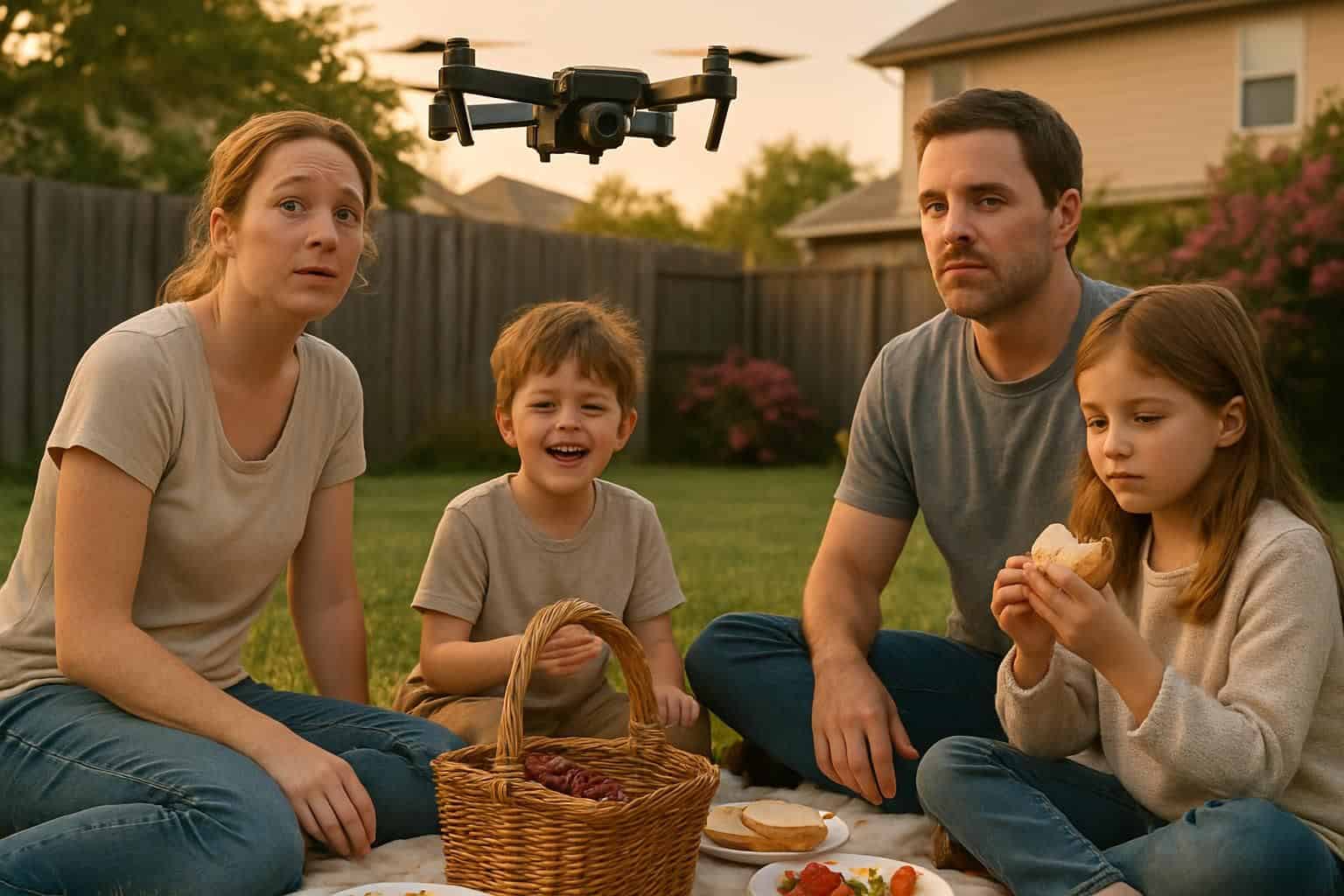
Drones buzzing over your property raise serious questions about your right to privacy in the digital age. Current laws about drone use vary by state, leaving many people confused about what’s legal and what crosses the line.
Privacy Invasion Risks
Camera-equipped drones can seriously threaten your personal privacy. These small aircraft can secretly peer into your backyard, record information without your permission, and even pick up private chats through open windows.
The California Consumer Privacy Act demands that drone users follow certain data-collection rules, but plenty of operators simply ignore the law. High-tech upgrades—like powerful zoom lenses and night-vision cameras—make drone spying an even bigger concern, allowing sneaky aerial views of homes or private property.
The greatest threat to privacy comes not from technology itself, but from how easily it can be misused without proper oversight.
Privacy groups actively push back against what they call “pervasive surveillance“, a problem worsened by these flying machines. The FAA mostly cares about safety rules and doesn’t really protect your privacy rights.
In some states, flying drones over someone’s property without approval can lead to misdemeanor charges, but catching offenders and enforcing the law isn’t always easy. Spotting whether a drone is tracking you—or just happens to be buzzing overhead—can get tricky.
Legal Regulations on Drone Usage
Drone regulations in the U.S. have changed quickly since 2013. The FAA sets strict guidelines for drone operators—like banning flights directly over people and requiring respect for privacy.
Eleven states currently mandate search warrants before police can use drones for surveillance, which protects citizens from unwanted spying. I remember registering my first drone and learning these rules carefully, which helped me avoid some hefty fines.
U.S. courts have decided that watching from the air, as long as it’s from public airspace, doesn’t violate the Fourth Amendment. This decision creates uncertainty around drone use by police or private investigators.
Drone pilots need to follow federal aviation laws and state privacy requirements, but these rules sometimes clash. Rules vary significantly for recreational flyers compared to commercial users or surveillance professionals.
How to Identify If a Drone Is Following You

Spotting a drone that’s tracking you requires knowing what to look for in the sky. You can learn to spot key signs like unusual flight patterns or the same drone showing up wherever you go.
Recognizing Drone Movement Patterns
Drones move differently than planes or birds. They can hover quietly in one position, then quickly dart away. This start-stop motion is a clear signal that you’re looking at a drone.
At night, their telltale lights—usually red, green, and white—stand out against the dark sky. By law, these anti-collision lights must remain visible from at least three miles away during night flights.
The distinct buzzing sound of a drone, combined with its erratic movement patterns, creates a digital fingerprint as unique as a human signature.
Sound is another reliable clue. Most drones produce a steady buzz, getting louder as they approach. Tech-minded folks can use websites like ADSB Exchange to locate certain drones nearby.
Simple binoculars are also handy, allowing you a closer look from a safe spot. Some drones used by authorities are tougher to identify, since they often come equipped with high-tech surveillance equipment.
Next up, we’ll cover ways to determine if drones nearby have cameras or lights focused directly at you.
Detecting Drone Cameras or Lights
Spotting drones overhead involves more than just tracking flight paths—you’ve got to pay close attention to their physical features too. Usually, drones have lights to help pilots steer safely in the dark or during sunset hours.
These lights typically include red and green bulbs on either side, with white or blue ones flashing on top. During evening strolls, I’ve spotted drone lights clearly from distances beyond 300 feet.
Another easy trick is to use the DroneWatcher app, which picks up radio signals drones regularly emit. Camera lenses attached to drones also tend to reflect sunlight briefly, creating quick glints or flashes that reveal their location.
Consumer-grade drones usually don’t come equipped with highly advanced cameras, so capturing precise details—like a person’s face—is tricky unless they’re really close. In fact, a drone has to hover roughly within 50 to 100 feet from you to get a clear facial shot.
RF sensors offer another practical way to detect drones, sensing wireless radio signals exchanged between the drone and its pilot. Last month, at our neighborhood-watch gathering, we tested a few of these sensors and successfully picked up three separate drones buzzing around nearby areas.
Even better, the FAA provides a list on its official site that includes authorized detection gear, none of which breaks federal laws banning device-signal jamming.
Steps to Take If You Feel Uncomfortable
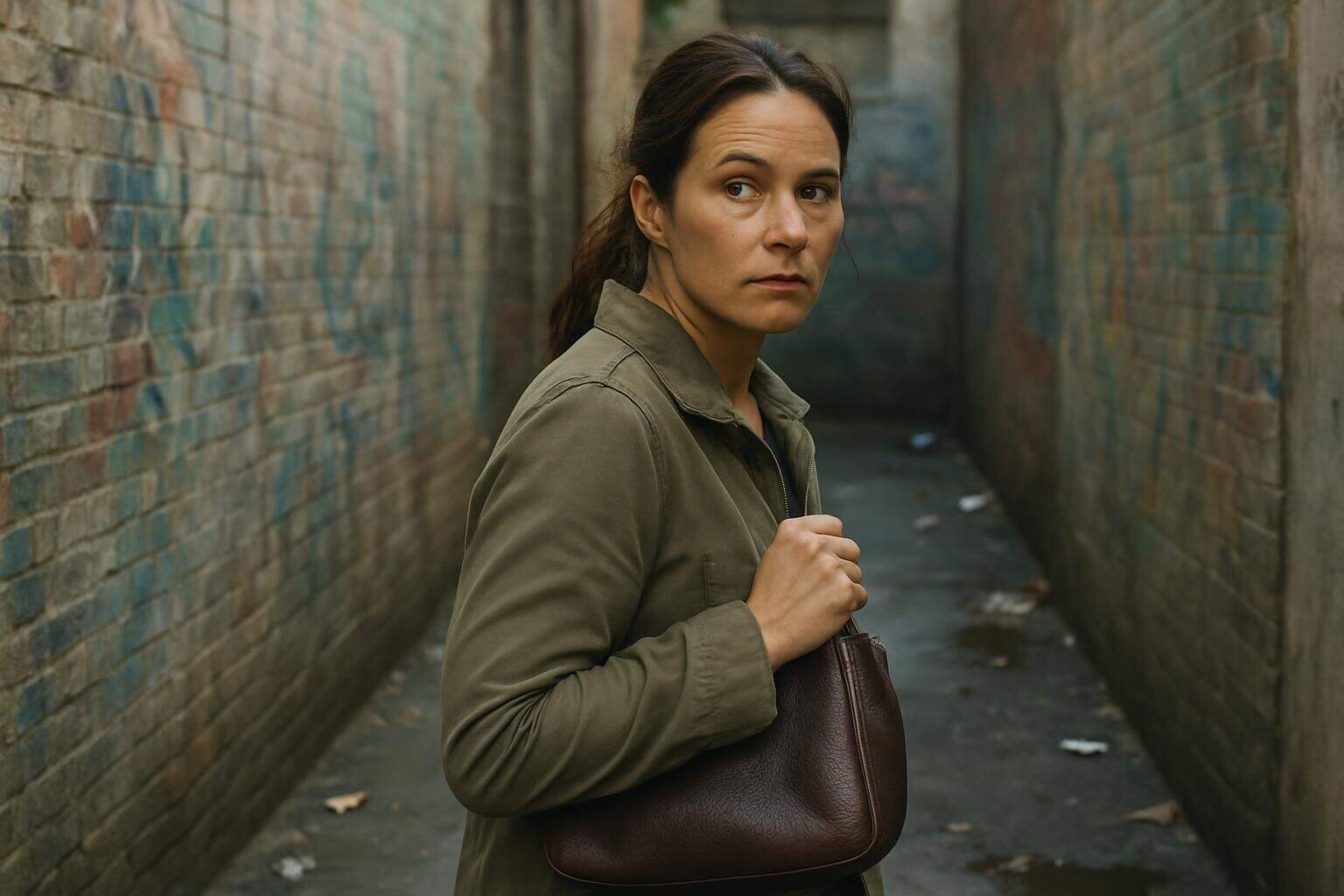
Feeling watched by a drone can be scary, but you have options to protect yourself. You can take clear steps to handle the situation and regain your sense of safety.
Attempt to Communicate With the Drone Operator
If you notice a drone hovering nearby, first try spotting its pilot. Usually, drone operators keep their aircraft within eyesight. Nearby, you might see someone holding a controller or staring intently at a screen.
Once, at the park, I saw a drone flying overhead and soon caught sight of its pilot standing beneath a tree, about 50 feet from me. Approaching with a friendly smile and wave usually does the trick.
Often, drone flyers aren’t even aware they’re causing discomfort—politely ask them what they’re filming. Most enthusiasts happily share details, and may even show off their aerial footage.
If the drone continues to follow you and there’s no pilot in sight, quickly note the exact time and location. The FAA rules say drone operators must always keep their equipment in clear sight.
Move toward an open, public area with plenty of people around if you start feeling unsafe. Local police can step in if there’s any worry about unwanted or suspicious drone behavior.
Before contacting officers, try capturing clear photos or videos as proof. Documentation like this helps law enforcement identify the drone owner—in cases involving stalking or privacy issues, these records can make a difference.
Commercial drones often feature clear company logos or labels, making identification and reporting much simpler.
Document Evidence of the Drone’s Activity
Got a drone following your every move? Here’s a simple tip—grab your phone and record it clearly. Snap detailed photos to clearly capture the drone’s position and its exact flight path.
According to the FAA website, solid documentation is key evidence for proving drone-related privacy invasions. On your Android, open a basic note-taking app, and record exact dates, times, and locations for each sighting.
Keeping track of these incidents makes it easier for authorities to spot a clear pattern and take your complaint seriously.
To file an effective aerial surveillance complaint, police require specific details. Take sharp notes with clear descriptions of the drone’s features, any unique markings, and exactly how long it stays hovering around you.
Your detailed observations may uncover situations like commercial drone operators or even police drones flying without proper authorization. Well-kept records can help protect your privacy and prevent unauthorized devices from collecting biometric data or running facial recognition without your agreement.
Report the Incident to Authorities
If you notice a drone following you, alert the local police immediately. Local authorities can intervene, stopping illegal drone use—like spying or invading personal privacy. Snap clear photos or record videos, jotting down specific details: exact time, location, and the drone’s appearance.
For issues related to FAA rules, reach out to your nearest FAA flight standards district office. FAA officials can investigate complaints thoroughly and hold drone operators accountable for breaking regulations.
This step becomes crucial if someone is using a drone for stalking, snooping around, or private investigations. In certain cases, you can even legally take down a drone yourself—but always double-check local laws ahead of time.
Contact the FAA for Drone-Related Concerns
The FAA gives clear guidance for people concerned about drones nearby. If you worry about government surveillance or unsafe drone behavior, just call the FAA’s UAS Support Center at 844-FLY-MY-UA (844-359-6982).
Once, a strange drone hovered oddly close to my home, making me uneasy—so I dialed that number. Their staff guided me step-by-step, showing me how to gather useful evidence and correctly submit a report.
Prefer contacting them by email? The FAA website has a simple online form designed for reporting issues with drones. Also, the FAA DroneZone platform lets you easily register a personal drone.
You can even explore useful resources there, like tips for aerial photography or clear legal guidelines for operating drones. Keeping drones registered this way helps authorities monitor commercial drone traffic and prevent harmful actions, like stalking or violating your personal privacy.
Real-Life Instances of Drones Following Individuals
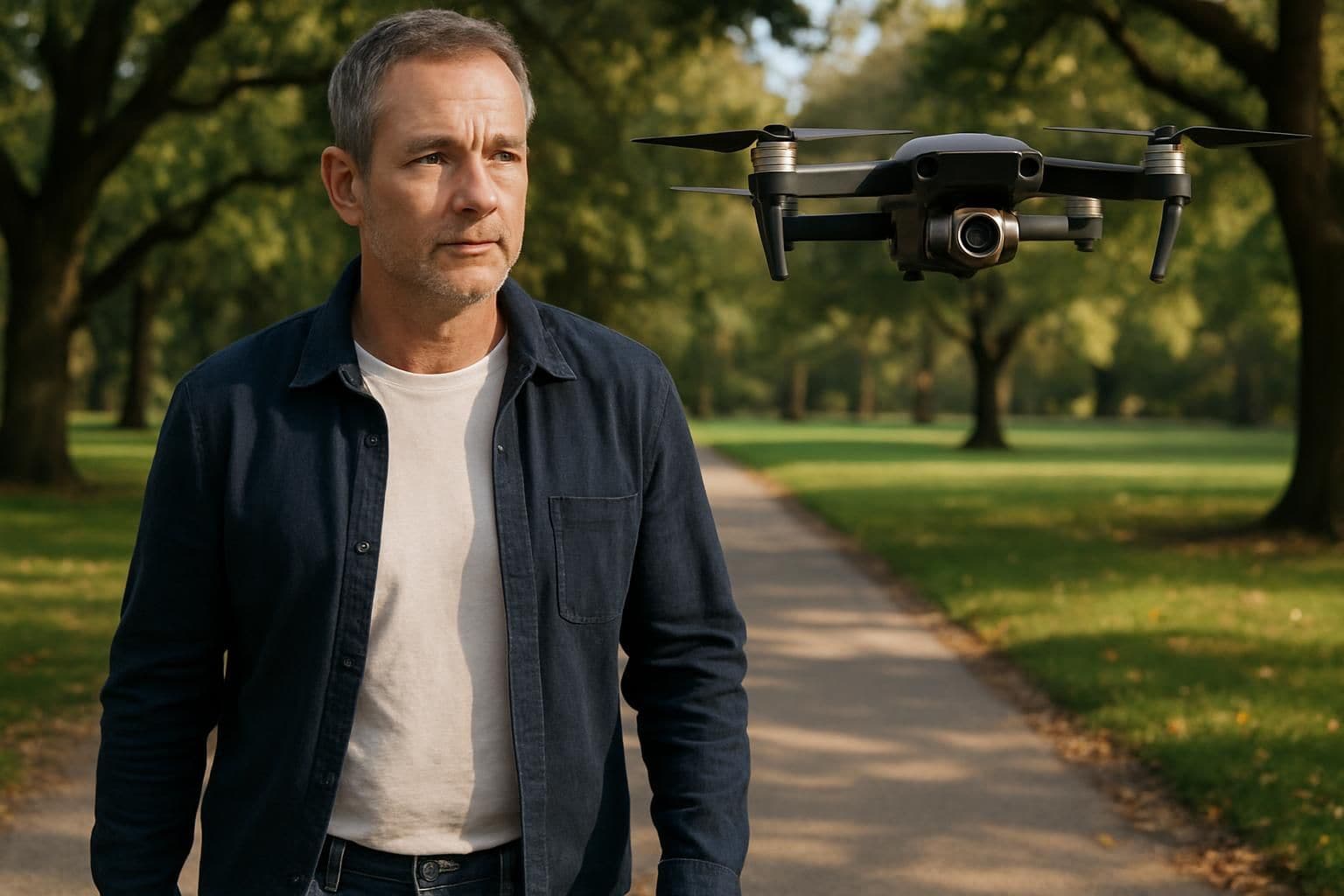
Drones have tracked people at protests and stalked them at home, raising major privacy concerns. Cases range from police using UAVs to monitor Black Lives Matter gatherings to private detectives flying robotic aircraft for divorce evidence.
Cases of Harassment or Stalking
People across the United States face frightening cases of drone stalking. Lynlee Thorne experienced weeks of harassment, watching helplessly as a drone hovered constantly above her Virginia farm.
Driven to desperation, she even attempted to shoot it down. Authorities eventually charged her stalker, Dustin Eugene Honeycutt, with criminal offenses. Another woman named Kim endured drone harassment from her ex-husband at a New Year’s Eve gathering—an unsettling invasion of her private life and personal safety.
Sadly, these are not rare examples. Law enforcement across the country notes a steady rise in reports of unwanted drone surveillance, often targeting women. Many drones carry advanced cameras with facial-recognition tech, which makes tracking someone through a crowd or onto private property surprisingly easy.
Private investigators, jealous exes, and controlling partners sometimes misuse drones for spying. Because drones are small and quiet, they easily hover outside bedroom windows or trail their targets discreetly.
Victims have noticed drones appearing repeatedly in places they frequent, suggesting a deliberate effort to monitor their daily routines. Such relentless stalking often triggers intense anxiety, fear, and feelings of helplessness.
So, how can you tell if a drone is actually following you—or simply passing by?
Misuse of Drones in Public Spaces
Drones are popping up at parks, beaches, and public gatherings without permission—sometimes in creepy ways. In the UK alone, officials recorded more than 2,400 cases of drones spying or stalking people.
One alarming incident took place in Gwent, where a woman was secretly recorded naked by a drone right outside her own home. Unfortunately, incidents like this aren’t rare at all. Even I’ve experienced it—a drone hovered by my apartment window for several minutes, flying off only after I spotted it.
Public spaces also face growing privacy risks from drones armed with facial recognition tech or license plate scanners. These flying devices can secretly track folks attending protests, like Black Lives Matter marches, and gather personal data without permission.
Some drones even carry biometric tools, able to pick out specific faces from crowded spots. Law enforcement agencies sometimes operate drone surveillance without getting warrants first, raising real concerns about personal rights in public settings.
Now, let’s consider how drone use and surveillance could evolve by 2025.
How Will Drone Surveillance Evolve in 2025?
By 2025, AI-powered drones will transform how we use airspace. These smart flying robots can quickly identify objects and plot flight paths without human assistance. In New York alone, drone usage is soaring—127 government agencies now operate 876 drone units, marking a 65% increase since 2022.
Law enforcement agencies will increasingly rely on drones, using thermal-imaging cameras to monitor crowds at events and protests.
The FAA plans to roll out new rules soon, especially about remote ID systems and flying drones beyond visual range. Privacy advocates worry about facial recognition software and personal rights connected to these changes.
Just last month, at a live drone demonstration, I saw a drone clearly read license plates from 200 feet above—opening concerns about warrantless searches. Job opportunities will change too; more certified pilots will be necessary to run fleets.
Police departments will need these drone operators, as will commercial sectors—real estate businesses wanting aerial images of properties or border patrol teams checking for illegal activities.
People Also Ask
Why would a drone be following me?
Drones can follow people for many reasons. Law enforcement agencies often use drones to track suspects or watch over high-crime neighborhoods. Some companies may fly drones for aerial photography or surveillance purposes. In uncommon cases, someone might use a drone to spy or secretly collect personal details about another person.
Can police use drones to catch people drinking and driving?
Yes, police drones could spot people driving under the influence of alcohol. These drones act similarly to license plate scanners in the sky, tracking vehicles that move oddly or dangerously. U.S. Customs and Border Protection also uses drones equipped with this technology to monitor cars near the border.
Are drones used during protests?
Police have used drones during events like Black Lives Matter protests. These drones can collect biometric data, even scanning faces to identify individuals in large crowds. Many protesters worry about privacy, as drones capturing their identities might then share that data widely.
What surveillance technologies do modern drones use?
Modern drones often carry sensors like those used by Flock Safety and ShotSpotter, designed to detect suspicious activities. Many drones can clearly read license plates from above and track people’s movements. The most advanced types even record conversations, or spot hidden items regular radar misses.
How can I protect myself from unwanted drone surveillance?
Understand your privacy rights under local laws. Take clear photos or videos of any suspicious drone activity, then share these with local police to report violations. Avoid using illegal drone-jamming equipment—those devices may land you in bigger legal trouble.
References
https://skywardwings.com/why-would-a-drone-be-following-me/
https://www.justanswer.com/law/dr5ez-noticed-drone-following-few.html (2020-03-26)
https://brownspace.org/why-would-a-drone-be-following-me/
https://skykam.co.uk/why-are-drones-following-me/ (2024-06-10)
https://www.butler.legal/florida-law-catches-up-to-stalking-drones/
https://pilotinstitute.com/drone-privacy/ (2025-05-21)
https://www.brookings.edu/articles/drones-and-aerial-surveillance-considerations-for-legislatures/
https://pilotinstitute.com/are-you-seeing-a-drone/
https://science.howstuffworks.com/drone-spying.htm
https://www.faa.gov/uas/contact_us/report_uas_sighting
https://www.faa.gov/uas/contact_us (2025-05-14)
https://www.autonomyglobal.co/counter-uas-technology-catching-a-drone-stalker/
